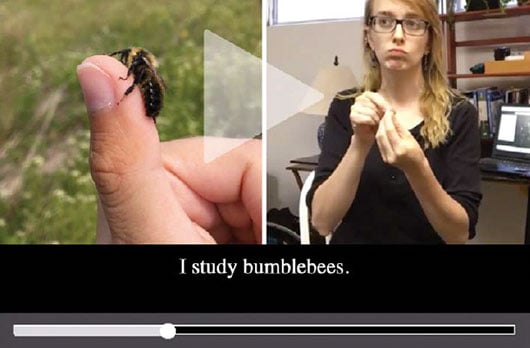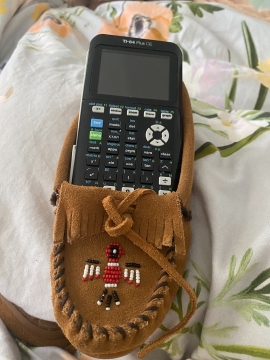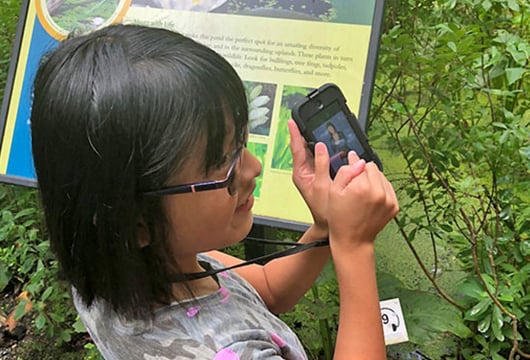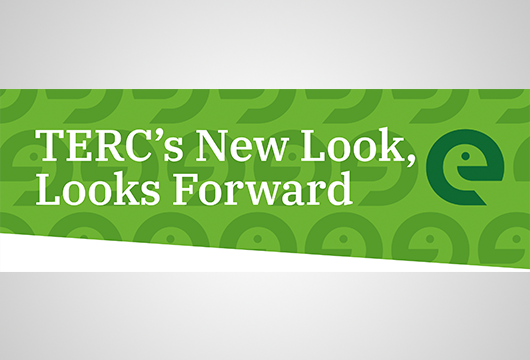TERC Blog
Introducing the Signing Bioscience Dictionary (SBD)
Why is the SBD Needed?
Students who are deaf or hard of hearing are not necessarily considered "print disabled." However, difficulties in acquisition of English literacy skills often arise due to early language delay. This results in considerable literacy limitations that lead to the majority of deaf students leaving high school with a reading level at the fifth grade or below. In fact, the English vocabulary of the average 15-year-old deaf child is about the size of that of the average 9-year-old hearing child and will not improve significantly (Qi & Michell, 2012).
Since most students who are deaf or hard of hearing and who use sign for communication are in classrooms that do not use sign language, interpreters are a frequent accommodation. Given this situation, the interpreter’s skills need to be taken into consideration. Most Interpreter Training Programs (ITP) focus on fluency in American Sign Language. However, most students enrolled in ITP programs have little or no science background and are not required to take general education courses in science as part of the curriculum (Graham et al., 2012). Those interpreters who are available may fail to make the language “visible” or comprehensible for learners and may rely heavily on fingerspelling and word-for-word transliteration, thereby rendering science course content minimally accessible (Seal, Wynn, & MacDonald, 2002).
This lack of formal and standardized training results in those students who require interpreting services in science classes being confronted by a scarcity of qualified and trained interpreters. Specifically, students in science courses frequently receive content translation from interpreters who are unfamiliar with concepts or do not have a command of the necessary specialized vocabulary needed for accurate interpretations (Gormally, 2017). When asked, interpreters often mention the need for opportunities for engaging in training related to providing services in the science disciplines. Many of them state that familiarity with and understanding of discipline-specific vocabulary usually happens by default—on the job (Grooms, 2015).
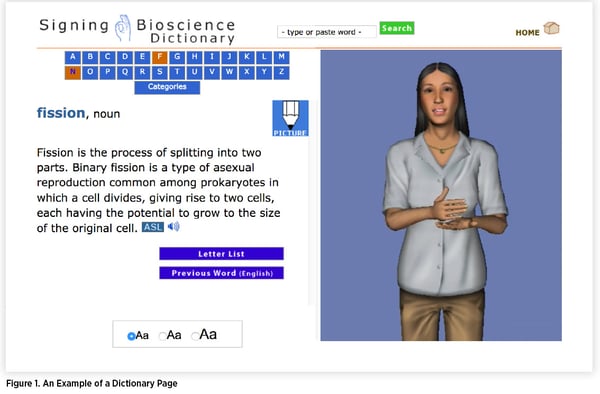
Complicating this state of affairs is the historic lack of a common sign-language lexicon for scientific terms. In recent years, several online databases that include ASL signs for technical scientific terms and concepts have become available. Among these are TERC’s Signing Math & Science Dictionaries. Although these were developed for grades K-12, we knew that interpreters were using the dictionaries to help them interpret undergraduate science material (Vesel & Robillard, 2014). This realization pointed to the need for a signing dictionary that specifically focused on terms used in undergraduate science courses. Working in partnership, TERC and Lamar University, with funding from NSF, developed such a dictionary in the form of a prototype Signing Bioscience Dictionary (SBD). We then conducted a first-of-its kind study to examine the use and effectiveness of the SBD in helping Lamar ITP students develop a robust technical vocabulary and interpret science content fluently and accurately.
What Terms and Features Have Been Incorporated into the SBD?
Development of the SBD involved the Lamar team in reviewing the glossary entries in Campbell Biology, 8th Edition to identify an initial set of terms. This text was selected because it is used at the university for their undergraduate biology courses. The review resulted in a list of terms, organized by text chapter, that were submitted to the TERC team, who then identified terms from the Lamar list that also appear in the signing dictionaries. The partners then identified additional terms that were not in the Lamar list but that are necessary for fully understanding the meaning of a signing dictionary term. The result was a final list of 1,580 terms.
The Lamar team then used the Campbell Biology chapter headings to create content categories for the terms in the final list. Review of the additional terms drawn from the signing dictionaries, with respect to their fit with a category, resulted in a final set of 12 categories. TERC adapted the existing interface for the signing dictionaries to create an SBD that is compatible with a wide variety of devices, platforms, and Web browsers.
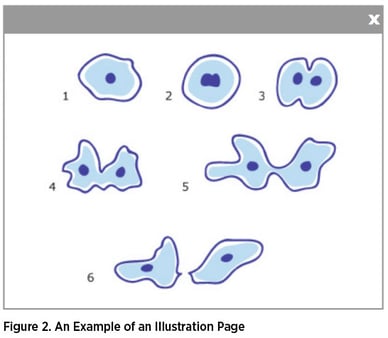
As is the case with the signing dictionaries, the SBD is “universally designed” according to the Universal Design for Learning (UDL) framework (Rose & Meyer, 2006). This type of design means that the interface incorporates interactive features to offer users multiple means of representing information, multiple means for expression of knowledge, and multiple means of engagement in learning. They can access each definition page by typing into a search box or selecting from alphabetical or category lists. They can select information represented as static images, text, human-voice narration and/or signing; they can increase or decrease size of the text; they can view a range of avatar characters. Figures 1 and 2 are examples of pages from the SBD.
What Does Our Research Show?
To evaluate use and effectiveness of the SBD, 28 interpreting students enrolled in Lamar’s ASL program used the SBD with each of three units: Reproduction; Heredity & Genetics; Ecology & Ecosystems. Prior to using the SBD, students were introduced to the unit of study. They then completed a Matching Vocabulary and Definition Pre-test, a Signing Pre-test, and a Pre-interpreting sample. Each instrument focused on terms for the unit that are found in the SBD. Students were then shown how to use the interactive SBD features. They used the SBD over the course of several weeks to practice signs, and while studying the meaning of terms on their own and while researchers observed them. At the end of the unit, they completed a Participant Survey that sought information about their perceptions regarding SBD use. They also completed a Matching Vocabulary and Definition Post-test, a Signing Post-test, and an Interpreting sample—all of which were the same as the pre-unit versions. This procedure was followed for each of the three units of study.
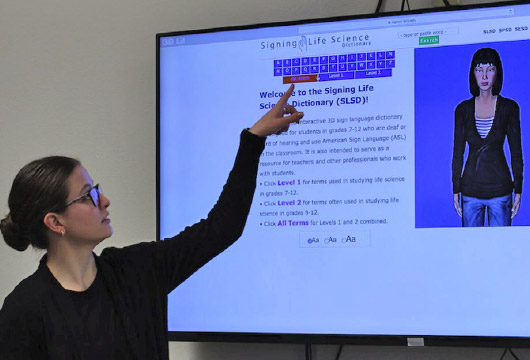 Figure 3. Introducing the SBD
Figure 3. Introducing the SBD
Results from the survey and differences between pre- and post-use scores supplied answers to the following four primary research questions:
-
How do Lamar undergraduate interpreting students use the SBD to learn life science terms?
-
How effective is the SBD in increasing Lamar undergraduate interpreting students’ knowledge of the vocabulary and their ability to sign life science terms?
-
How effective is the SBD in increasing Lamar undergraduate interpreting students’ capacity to accurately and clearly interpret content typically taught in undergraduate biology courses?
-
What additions and/or changes would make the SBD more effective?
We learned from observing interpreting students and from their responses to survey questions that most students found the SBD helpful and easy to use, had fun using it, and would use it again. They used the interactive features to look up terms in ASL and English, see words signed, view illustrations, learn new signs, and learn more about life science. All participants found that using the dictionary made learning science terms and definitions easier and helped them learn on their own. They were generally satisfied with the information that was available for each term, with the accuracy of the signs, with their ability to understand the avatar, and with the avatar’s facial expressions. Some preferred a human signer to an avatar or thought the avatar was difficult to understand. Additionally, some found the avatar’s signing choppy. Some felt the contrast between the avatar’s clothing and skin color to be insufficient and that this interfered with seeing the signing. These results will be used to make changes to the SBD to render it more effective.
We also learned that SBD use increased students’ knowledge of the life science content and related vocabulary presented in the definitions, and that they were able to learn this vocabulary rather quickly. However, much of this vocabulary includes fingerspelling, and it became clear that many of the students were not skilled in using morphology to “chunk” items to make them easier to sign. In addition, they were unable to fingerspell terms and then set up an expansion using depiction constructions or classifiers, which are ASL structures that establish a pronoun-like referent, to convey the information in a fluent manner. Depiction constructions are representations of nonliteral behaviors in a visual-spatial format. Their use allows abstract ideas to become visual.

Given the complexity of life science content, interpreting students need to master these skills in order to be effective and fluent interpreters for deaf students.
Current research (NSF Award #2019843) is examining involvement of ITP students in developing these ASL skills. For example, they can be explicitly taught to chunk fingerspelling into morphemes to increase ease of comprehension through modelling and training, thereby enabling them to sign more like native signers when they fingerspell. In addition, native signers can develop examples of expansions using depiction constructions so that interpreting students gain deeper comprehension by connecting the fingerspelling of a word to its expansion. For example, when the functions of the body are being described, depiction constructions act as a surrogate of a human body and provide a step-by-step process that is easy to follow. By viewing native signers using these constructions, and then being trained in how to use constructions in interpreting situations, interpreters should be able to more effectively communicate life science lecture and classroom content. However, further research is needed to verify this.
In conclusion, this study found that student interpreters benefit from learning science vocabulary but need more support to become skilled in using that vocabulary to interpret science content. It is critical to address this need, as interpreters often accept a job that involves science interpreting, do it once, and then decline subsequent jobs because they find they do not have the necessary skills to interpret science well.* Addressing this need during a four-year interpreter training program will likely increase access to science content for deaf and hard of hearing undergraduate students. As a result, more students who are deaf or hard of hearing may pursue STEM fields and ultimately choose a STEM career or a career that involves STEM.
Where are Downloads Available?
For more information about our research and to download the SBD, visit our project website at https://signsci.terc.edu/video/SBD_index.html
Download Hands On! Fall 2020
Authors
Judy Vesel is a Principal Investigator at TERC. She has degrees in Biology, Linguistics, and Education. She was the Principal Investigator for the Leveraging Learning and Science for Today and Tomorrow projects (funded by NSF). She is the Principal Investigator for a body of work referred to as “Signing Math & Science”– funded by NSF and the U.S. Department of Education. Her experience as an educator and administrator extends from the primary grades through high school. Ms. Vesel has presented her work at many recent conferences including annual meetings of the Center for Advancement of Informal Science Education (CAISE), American Association of Museums (AAM), Assistive Technology Industry Association (ATIA), and Closing the Gap. E-mail: judy_vesel@terc.edu
M. Diane Clark is a full professor and chair of the Department of Deaf Studies and Deaf Education at Lamar University. Prior to coming to Lamar, she was a full professor at Gallaudet University and Program Director for their Ph.D. program in Critical Studies in the Education of Deaf Learners. She has a background in the cognitive development of deaf individuals. Her current publications have included the development of the Visual Communication and Sign Language Checklist, the Beliefs and Attitudes about Deaf Education Questionnaire, as well as projects that investigate successful deaf readers. E-mail: diane.clark@lamar.edu
Tara Robillard is a research associate at TERC. She has degrees in Marine Science and Science Education and taught at the high school level. Her research interests focus on accessibility for students with low-incidence disabilities, especially the use of universally designed technology innovations to improve achievement in mathematics and science of students who are deaf or hard of hearing. E-mail: tara_robillard@terc.edu
References
Gormally, C. (2017). Deaf, hard-of-hearing, and hearing signing undergraduates’ attitudes toward science in inquiry-based biology laboratory classes. CBE—Life Sciences Education, 16(1), ar6.
Graham, S., Solomon, C., Marchut, A., Kushalnagar, R., & Painter, R. (2012). Experiences of students in STEM. In C. Solomon (Ed.), Workshop for emerging deaf and hard of hearing scientists [White Paper] (pp. 13-19). Washington, DC: Gallaudet University.
Grooms, C. (2015). Interpreter competencies in science, technology, engineering, and mathematics as identified by deaf professionals. [Master’s thesis, Paper 18]. Retrieved from: http://digitalcommons.wou.edu/theses/18/
Qi, S., & Mitchell, R. (2012). Large-scale academic achievement testing of deaf and hard-of-hearing students: Past, present, and future. Journal of Deaf Studies and Deaf Education, 17(1): 1-18.
Rose, D., & Meyer, A. (2006). A practical reader in universal design for learning. Cambridge, MA: Harvard Education Press.
Seal, B.C., Wynne, D.H., & MacDonald, G. (2002). Deaf students, teachers, and interpreters in the chemistry lab. Journal of Chemical Education. 79(2): 239-243. Retrieved from: http://pubs.acs.org/doi/abs/10.1021/ed079p239
Vesel, J., & Robillard, T. (2014). Increasing access to technical science vocabulary through use of universally designed signing dictionaries. In S. Burgstahler (Ed.), Universal design in higher education: Promising practices. Seattle: DO-IT, University of Washington.
Credits
The Signing Bioscience Dictionary is being researched and developed by TERC and Lamar University and funded in part by the National Science Foundation, Grant #1703343. All opinions, findings, conclusions, and recommendations expressed herein are those of the authors and do not necessarily reflect the views of the funders.

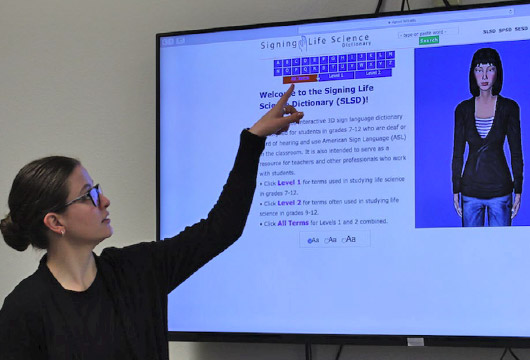





.gif)
